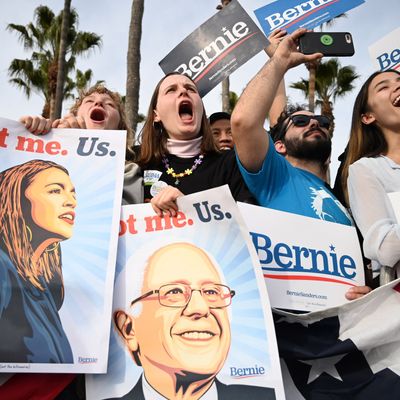
In 2016, Bernie Sanders owed much of his primary campaign’s unexpected viability to his popularity with young voters. As he was coming into the crowded field of competitors for the 2020 race, though, repeat success wasn’t necessarily a foregone conclusion. But Sanders’s success with the youth now looks durable. He leads with them, still, in the polls, and this past week, two influential youth-led progressive organizations endorsed the democratic socialist for president: Dream Defenders, a Florida-based civil-rights group formed in the wake of Trayvon Martin’s killing, and the Sunrise Movement, which advocates for the Green New Deal.
In a statement, the environmental group said 78 percent of its membership favored Sanders. Just over 80 percent of its voting members are under 35.
The source of Sanders’s youth appeal appears to be much the same as it was in 2016: Student-loan debt and escalating health-care costs are still significant burdens for young people, and incremental solutions, like those favored by the more moderate candidates in the race, seem unequal to the radical challenges they face.
Young adults themselves are clear about the case for Sanders. “Bernie is not our political savior. It is the movement behind him that will change this country. We are not electing a savior; we are electing a political opponent who we will hold accountable to meet our demands,” the Dream Defenders’ Fight PAC explained on its website. The statement singled out the Vermont senator’s positions on free public college, Medicare for All, and the abolition of draconian three-strikes laws and the death penalty, among other issues, as areas where his platform aligns closely with their values. Similarly, Sanders’s consistent support for Green New Deal legislation and his activist background swayed Sunrise members in his favor. “Senator Sanders has repeatedly claimed that, as president, he would be the ‘organizer-in-chief.’ We hope we’ll get the opportunity to hold him accountable to that,” the organization’s statement read.
As opposed to 2016, when he faced only one other candidate in the primary, Sanders does face stiffer competition for the youth vote this year. Morning Consult reported in 2019 that his share of the youth vote had declined slightly over the life of the primary thus far with Joe Biden and Elizabeth Warren cutting into his overall support. The crowded field notwithstanding, Sanders still enjoys a wide lead among young voters.
That might not be enough to win him the primary, though. Sanders won an astonishing percentage of the youth vote in 2016 — more than Donald Trump and Hillary Clinton combined, according to the Center for Information and Research on Civic Learning and Engagement at Tufts University. Voters under 30 made up around 17 percent of the primary electorate in 2016, CBS reported at the time, but there’s some evidence that young people intend to vote in greater numbers in 2020. Last April, a Harvard University Institute of Politics poll indicated that 43 percent intend to participate in the primary process, up from 36 percent as measured by the same poll in 2016. If more young adults do vote in the primaries, that might be bad news for the other candidates. The field is still swollen, and there are few ways for candidates to carve out a realistic path to the nomination. In most years, youth voters might not be numerous enough to deliver Sanders the primary on their own strength. But with so many candidates competing for votes, a committed, cohesive bloc of young adults could make a real difference for him in his quest for the nomination.
Sanders’s youth support also has implications for the general election. Though young voters don’t historically turn out in high numbers, at least not compared with seniors (the Biden bloc), outrage over Trump could change things. The U.S. Census found that for the midterm elections in 2018, voter turnout among adults ages 18 to 29 increased by 14 points over 2014. Party leaders may indeed be worried about Sanders’s winning the nomination, as a recent report by the Associated Press suggested. But if they want to avoid reviving the enthusiasm gap that helped cost Clinton the election in 2016, they may want to pay attention to what young voters say they want.






























